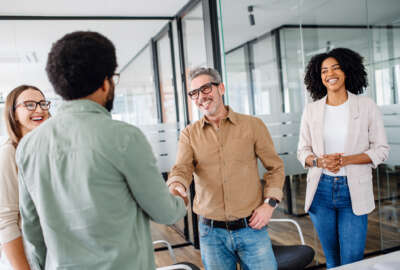Nonmanufacturer rule waiver and set-asides: An unintended consequence for domestic manufacturers
This column was originally published on Roger Waldron’s blog at The Coalition for Government Procurement and was republished here with permission from the...
This column was originally published on Roger Waldron’s blog at The Coalition for Government Procurement and was republished here with permission from the author.
According to the Small Business Administration (SBA), “[t]he federal government prefers to contract with small businesses whenever possible. Contracting officials can use set-aside and sole-source contracts to help their agencies meet their small business contracting goals.” Small business contracting is an important means to create opportunity and promote continuous innovation. There is an issue attendant to small business contracting, however, that should be highlighted, as it may have implications for the federal market and opportunities for domestic manufacturers. Specifically, the interplay between the small business rules, the Buy American Act (BAA), and the Trade Agreements Act (TAA), under certain circumstances, likely will reduce federal market access for domestic manufacturers (small, medium, and large).
Readers may recall that, for a firm to qualify as a small business for the purposes of a small-business set-aside, it must be the manufacturer of the end-item being purchased (and that item must be manufactured in the U.S.), or it must qualify as a non-manufacturer. Cf. 13 CFR 121.406. A firm of 500 or less employees qualifies as a non-manufacturer if it:
… is primarily engaged in the retail or wholesale trade and normally sells the type of item being supplied;
… takes ownership or possession of the item(s) with its personnel, equipment or facilities in a manner consistent with industry practice; and
… will supply the end item of a small business manufacturer, processor or producer made in the United States, or obtains a waiver of such requirement … .
Id. at 121.406(b)(1).
The SBA Administrator may waive this non-manufacturer rule when SBA reviews and accepts the contracting officer determination that no small business manufacturer “reasonably can be expected to offer a product meeting the” solicitation specifications (an individual waiver), or when SBA determines that no small business manufacturer “product or class of products is available to participate in the Federal procurement market” (class waiver). Id. at 121.406(b)(5), (6). Under a waiver,
“[a] firm can supply the product of any size business without regard to the place of manufacture. However, SBA’s waiver of the non-manufacturer rule has no effect on requirements external to the Small Business Act which involve domestic sources of supply, such as the Buy American Act or the Trade Agreements Act.”
Id. at 121.406(b)(7).
The TAA restricts the acquisition of products to those from manufacturers in the U.S. and certain “designated countries,” i.e., countries, generally, that have a Free Trade Agreement with the U.S. or participate in the World Trade Organization Government Procurement Agreement (WTO GPA). See FAR 25.003. Thus, under the TAA, products from non-signatory countries, (e.g. China) are not eligible for award.
The BAA also restricts the purchase of non-domestic end-products. FAR 25.101(a). The BAA, however, includes specified exceptions that provide potentially broader access to foreign end-products than under the TAA. There are BAA exceptions where the domestic offer is not the low offer, see FAR 25.103, and for matters, like the public interest, for certain circumstances of product non-availability in the U.S., and unreasonable item cost. With regard to circumstances where the domestic offer is not the low offer, the BAA calls for the use of a price adjustment factor to be added to the low foreign offer when evaluating offers for award.
FAR 25.402(a)(1) implements the TAA “authority for the President to waive the Buy American statute and other discriminatory provisions for eligible products” from designated countries. It appears, by operation of regulations, however, the TAA does not apply to small business set-asides, FAR 25.401, leaving in place the BAA. This makes sense where the set-aside requirement is to provide the product of a domestic small business. The waiver of the non-manufacturer rule for a set-aside, however, appears to give rise to a counterintuitive result.
Specifically, the TAA is inapplicable to set-asides, and the BAA apparently is applicable to set-asides where the non- nonmanufacturer rule has been waived. As a result, the Government could find itself almost compelled to purchase a product, like a medical-surgical product, manufactured in a non-designated country that has subsidized its price to assure the product’s selection. In essence, then, the law intending to restrict non-domestic end-products (the BAA) actually could operate to facilitate more access to such products, including the products of manufacturers located in non-designated countries, rather than the providing controlled access to non-domestic end-products (as for example under the TAA). Moreover, the application of the BAA in this context could harm small and other-than-small domestic manufacturers. In essence, this reading of the regulations could open up small business set-asides to products made in China that would otherwise be ineligible for purchase if the TAA applied. This operation of regulations is curious, to say the least, and, without more statutory guidance, needs further analysis. In the meantime, the Government will have to be cognizant of this potential outcome, and vendors will have to check for their compliance obligations.
It is up to policy stakeholders and the courts to determine whether the existing regulations make sense when contrasted with the letter and intent of the statutes involved here. Clearly, this construct has significant implications for the Government’s needs for minimized supply chain risk and a strong domestic industrial base. In any case, this discussion serves to highlight the ever-changing environment in which the Government operates and the complex rules to which it must adhere. It also demonstrates the importance of understanding the interplay between applicable laws, not only for the sake of compliance, but also to mitigate risk and maximize opportunities to the industrial base.
Copyright © 2025 Federal News Network. All rights reserved. This website is not intended for users located within the European Economic Area.






